Podczas udostępniania treści witryny WordPress na Facebooku ważne jest, aby upewnić się, że wygląda ona atrakcyjnie i angażująco. Metadane Facebook Open Graph pozwalają kontrolować sposób wyświetlania postów i stron po udostępnieniu na platformie, poprawiając ich atrakcyjność wizualną.
Te metadane dostarczają Facebookowi konkretnych informacji na temat treści, umożliwiając dostosowanie tytułu, opisu, wyróżnionego obrazu i innych elementów wyświetlanych w udostępnianych postach.
Odkryliśmy, że dostarczanie dokładnych i angażujących metadanych może zwiększyć szanse na to, że użytkownicy klikną na twoją stronę, zwiększając ruch i zaangażowanie
W tym artykule pokażemy, jak łatwo dodać metadane Facebook Open Graph w motywach WordPress. Podzielimy się trzema różnymi metodami, w tym metodą All in One SEO, której używamy w WPBeginner, abyś mógł wybrać tę, która najlepiej pasuje do Twojej witryny WordPress.

Możesz skorzystać z poniższych odnośników, aby przejść bezpośrednio do metody, która najbardziej Cię interesuje:
Metoda 1: Dodawanie metadanych Facebook Open Graph za pomocą AIOSEO
All in One SEO to popularna wtyczka WordPress SEO używana przez ponad 3 miliony witryn internetowych. Pozwala ona łatwo zoptymalizować twoją witrynę internetową pod kątem wyszukiwarek, a także platform społecznościowych, takich jak Facebook i Twitter.
Najpierw należy zainstalować i włączyć darmową wtyczkę All in One SEO. Aby uzyskać więcej informacji, zobacz nasz przewodnik krok po kroku, jak zainstalować wtyczkę WordPress.
Po włączaniu należy przejść na stronę All in One SEO ” Media społecznościowe. Tutaj możesz wpisz adres URL twojej strony na Facebooku i wszystkich innych mediów społecznościowych.
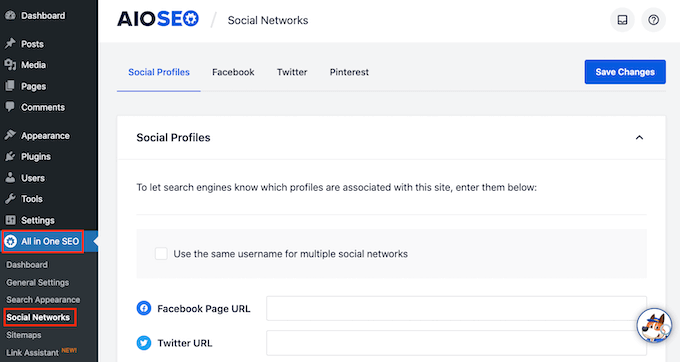
Następnie kliknij kartę Facebook u góry strony, a zobaczysz, że znaczniki Open Graph są domyślnie włączone.
Możesz kliknąć przycisk “Prześlij lub wybierz obrazek”, aby wybrać domyślny obrazek Facebook OG, jeśli artykuł nie ma obrazka Open Graph.
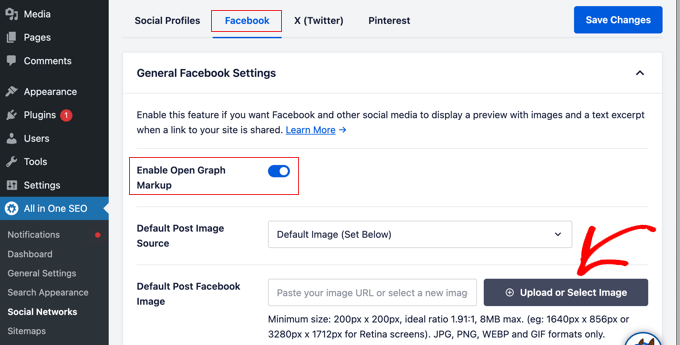
Jeśli przewiniesz w dół, możesz dostosować własną nazwę witryny, opis i inne ustawienia. Nie zapomnij kliknąć niebieskiego przycisku “Zapisz zmiany” po zakończeniu.
Po ustawieniu metatagów Open Graph dla całej witryny, następnym krokiem jest dodanie metadanych Open Graph dla poszczególnych wpisów i stron.
Domyślnie AIOSEO użyje tytułu i opisu Twojego wpisu jako tytułu i opisu Open Graph. Możesz także ręcznie ustawić miniaturkę Facebooka dla każdej strony i wpisu.
Wystarczy edytować wpis lub stronę i przewinąć w dół do sekcji “Ustawienia AIOSEO” poniżej edytora. Z tego miejsca przełącz się na kartę Społecznościowe, a zobaczysz podgląd twojej miniaturki.
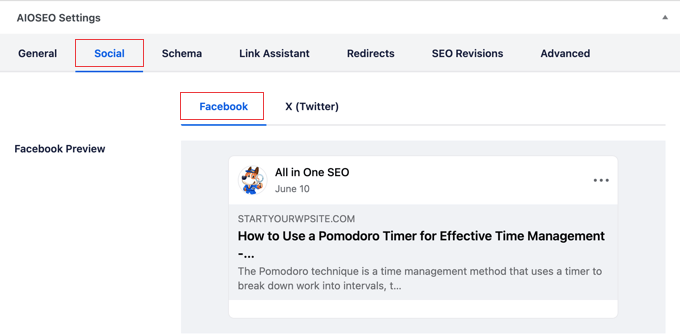
Można tu ustawić obrazek mediów społecznościowych, a także tytuł i opis.
Wystarczy przewinąć w dół do pola “Źródło obrazka”. Możesz użyć wyróżniającego się obrazka, przesłać własny obrazek lub skorzystać z innych opcji.
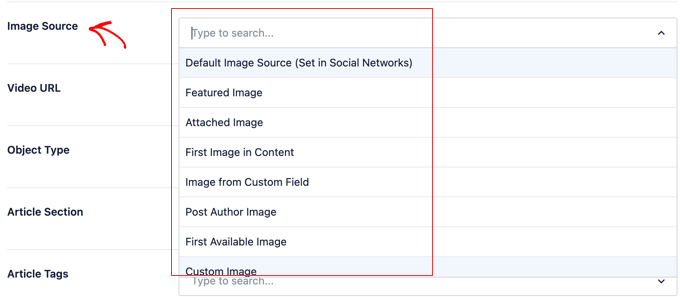
Metoda 2: Ustaw metadane Facebook Open Graph za pomocą Yoast SEO
Yoast SEO to kolejna wtyczka WordPress SEO, której można użyć do dodania metadanych Facebook Open Graph do dowolnej witryny WordPress.
Pierwszą rzeczą, którą musisz zrobić, jest zainstalowanie i włączanie wtyczki Yoast SEO. Aby uzyskać więcej informacji, zapoznaj się z naszym przewodnikiem krok po kroku, jak zainstalować wtyczkę WordPress.
Po włączaniu, dane Facebook Open Graph są domyślnie włączone.
Możesz to sprawdzić, przechodząc do Yoast SEO ” Ustawienia i przewijając w dół do sekcji Udostępnianie społecznościowe. Teraz możesz upewnić się, że funkcja danych Open Graph jest włączona.
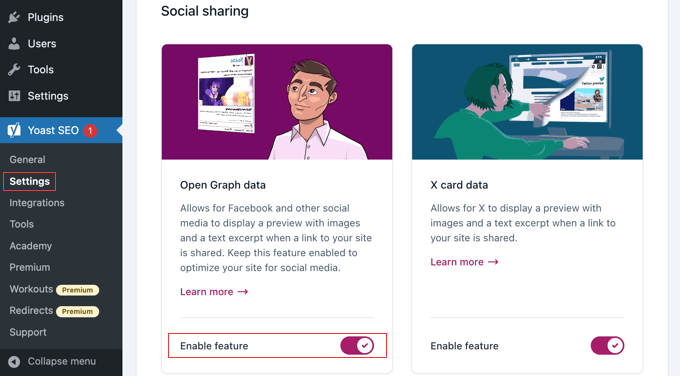
należy przejść do SEO ” Społecznościowe i wybrać opcję “Włączone” w sekcji “Dodaj metadane Open Graph”.
Możesz zapisać twoje ustawienia lub kontynuować i skonfigurować inne opcje społecznościowe Facebooka.
Możesz podać identyfikator aplikacji Facebook, jeśli używasz go dla Twojej strony na Facebooku i insights. Możesz również zmienić tytuł, opis i obrazek Twojej strony głównej Open Graph.
Wreszcie, można ustawić domyślny obrazek, który będzie używany, gdy żaden obrazek nie jest ustawiony dla wpisu lub strony.
Wersja Premium Yoast SEO pozwala również na ustawienie metadanych Open Graph dla poszczególnych wpisów i stron. Wystarczy edytować wpis lub stronę i przewinąć w dół do sekcji “Yoast SEO” poniżej edytora.
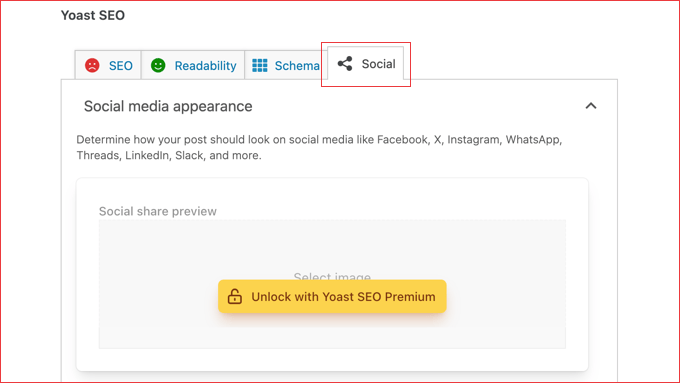
W tym miejscu można ustawić miniaturkę Facebooka dla danego wpisu lub strony. Jeśli nie ustawisz tytułu lub opisu wpisu, wtyczka użyje twojego meta tytułu i opisu SEO.
Możesz teraz zapisać swój wpis lub stronę, a wtyczka zapisze Twoje metadane Facebook Open Graph.
Metoda 3: Dodawanie metadanych Facebook Open Graph za pomocą kodu
Ta metoda zazwyczaj wymaga skopiowania i wklejenia kodu do pliku functions.php twojego motywu . Zalecamy jednak dodanie kodu za pomocą wtyczki WPCode, która ułatwia i zwiększa bezpieczeństwo dodawania własnego konfiguratora w WordPress.
WPCode zawiera również bibliotekę gotowych fragmentów kodu, w tym jeden do dodawania podstawowych tagów Open Graph, więc zajmuje to tylko kilka kliknięć.
Najpierw zainstaluj i włącz darmową wtyczkę WPCode. Więcej szczegółów można znaleźć w naszym przewodniku na temat instalacji wtyczki WordPress.
Po włączaniu, możesz przejść do Code Snippets ” + Add Snippet z twojego kokpitu WordPress.
Wyszukaj w bibliotece fragment kodu “Dodaj podstawowe tagi Open Graph”. Gdy go znajdziesz, najedź na niego kursorem i kliknij przycisk “Użyj fragmentu kodu”.

Następnie WPCode automatycznie doda kod, a także ustawi nagłówek witryny jako lokalizację metody wstawienia.
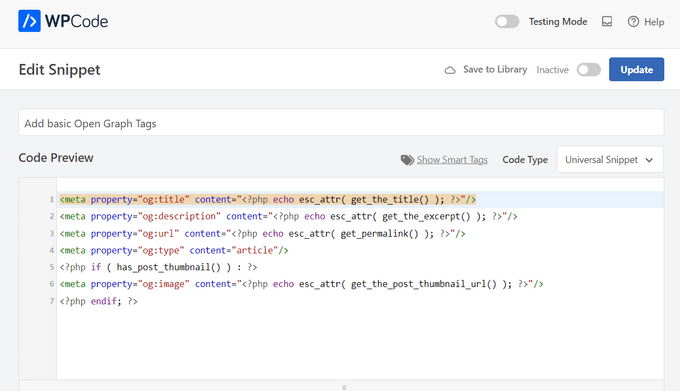
Następnie wystarczy przełączyć fragment kodu na “Aktywny” i kliknąć przycisk “Aktualizuj”. Twój motyw zacznie teraz wyświetlać metadane Facebook Open Graph w nagłówku WordPress.

Jeśli jesteś zaawansowanym użytkownikiem, możesz skopiować i wkleić poniższy kod do pliku functions.php twojego motywu.
Ponieważ wymaga to bezpośredniej edycji plików twojego motywu, upewnij się, że wykonałeś kopię zapasową plików motywu przed wprowadzeniem jakichkolwiek zmian.
1 2 3 4 5 6 7 8 9 10 11 12 13 14 15 16 17 18 19 20 21 22 23 24 25 26 27 28 29 | //Adding the Open Graph in the Language Attributesfunction add_opengraph_doctype( $output ) { return $output . ' xmlns:og="http://opengraphprotocol.org/schema/" xmlns:fb="http://www.facebook.com/2008/fbml"'; }add_filter('language_attributes', 'add_opengraph_doctype'); //Lets add Open Graph Meta Info function insert_fb_in_head() { global $post; if ( !is_singular()) //if it is not a post or a page return; echo '<meta property="fb:app_id" content="Your Facebook App ID" />'; echo '<meta property="og:title" content="' . get_the_title() . '"/>'; echo '<meta property="og:type" content="article"/>'; echo '<meta property="og:url" content="' . get_permalink() . '"/>'; echo '<meta property="og:site_name" content="Your Site Name Goes Here"/>'; if(!has_post_thumbnail( $post->ID )) { //the post does not have featured image, use a default image $default_image="http://example.com/image.jpg"; //replace this with a default image on your server or an image in your media library echo '<meta property="og:image" content="' . $default_image . '"/>'; } else{ $thumbnail_src = wp_get_attachment_image_src( get_post_thumbnail_id( $post->ID ), 'medium' ); echo '<meta property="og:image" content="' . esc_attr( $thumbnail_src[0] ) . '"/>'; } echo "";}add_action( 'wp_head', 'insert_fb_in_head', 5 ); |
Pamiętaj, aby dodać nazwę twojej witryny w linii 17, gdzie jest napisane “Your Site Name Goes Here”. Następnie należy zmienić domyślny adres URL obrazka w wierszu 19 na jeden z twoich własnych adresów URL obrazków.
Zalecamy umieszczenie tam obrazka z Twoim logo, więc jeśli Twój wpis nie ma miniaturki, to pobierze logo Twojej witryny.
Musisz również dodać twój identyfikator aplikacji Facebook w linii 13. Jeśli nie masz aplikacji Facebook, możesz usuwać linię 13 z kodu.
Przewodniki ekspertów na temat Facebooka i WordPressa
Mamy nadzieję, że ten artykuł pomógł ci dodać metadane Facebook Open Graph w WordPress. Możesz również zapoznać się z innymi przewodnikami dotyczącymi korzystania z Facebooka w WordPress:
- Najlepsze porady i poradniki dotyczące Facebooka dla użytkowników WordPressa
- Jak automatycznie wpisywać posty na Facebooku z WordPressa?
- Jak zainstalować i skonfigurować komentarze na Facebooku w WordPressie?
- Jak stworzyć własny Facebook Feed w WordPressie?
- Jak wyświetlić recenzje twojej strony na Facebooku w WordPressie?
- Jak naprawić problem z niepoprawną miniaturką na Facebooku w WordPress?
- Jak wyświetlić Twittera i Facebooka autora na stronie profilu?
- Jak stworzyć stronę docelową Facebook Ads w WordPressie?
- Jak naprawić problem oEmbed Facebooka i Instagrama w WordPressie?
If you liked this article, then please subscribe to our YouTube Channel for WordPress video tutorials. You can also find us on Twitter and Facebook.





wpbeginner
@SteveJoseph@joshuatj Josh not sure when you last checked the plugin, but our plugin has full support for the og:description. It has been there since version 0.1.2. Here is the changelog:http://wordpress.org/extend/plugins/facebook-open-graph-meta-in-wordpress/changelog/In version 0.1.3, we improved the description code to actually look for Yoast’s plugin’s description code, and if that doesn’t exist then it pulls the post excerpt if that exists.
SteveJoseph
@joshuatj Good point and thanks again for the links and your help. It’s much appreciated. Between Linter and the Yoast plugin I should be ok. All the best.
joshuatj
@SteveJoseph Or you can wait till Facebook do their Lint run.
SteveJoseph
@joshuatj I tried linter before but that only fixed the 1st post. The rest still display the old copy. I just realized however that if I lint each unique page then it shows the correct information which is what you’ve posted above. Annoying but I guess this is what I’ll need to use for now or check out the link you provided and see if that plugin works for me. Much thanks mate! Cheers.
joshuatj
@SteveJoseph Oops, you’re right, I did make a typo mistake there. I meant “Yoast”. http://yoast.com/wordpress/seo/But in actual fact, Yoast does more than just solving the og-description issue, so it might not be what you want. I just used URL Linter (http://developers.facebook.com/tools/lint/) for your site. It seem to be displaying this description “Future Tomorrow is the collective online moniker, portfolio site and blog of Steve Joseph. With over 14yrs creative experience across several disciplines and knowledge that far extends beyond “just being a creative”, there is much to share but still more to learn.”. Is that what you want in the description field? Try “sharing on Facebook” again?
SteveJoseph
@joshuatj Thanks for the response joshuatj. Unfortunately a search of “Yeost Facebook Plugin” or “Yeost Plugin” didn’t return any helpful results in guiding me to this possible solution. Do you have a direct link?
I also tried searching “Yoast” thinking there may have been a typo in your response and that still didn’t lead me to a solution. Any further help would be greatly appreciated. Thanks for your time.
joshuatj
@SteveJoseph I don’t think this plugin deals with description. Try Yeost’s?
SteveJoseph
sorry for no link – http://futuretomorrow.net/blog/ – click on “share this on Facebook” on any post to see what’s happening in visual detail. Thanks again.
SteveJoseph
Hi,
I tried both your plug-in and code method and neither worked. When clicking “share this on Facebook” from my blog, my title is correct, URL is correct, image is correct but the description is old and incorrect. Is there an update to the code or plug-in where the “description” is properly displayed?Thanks in advance.
Cheers,
Steve
joshuatj
The plugin is awesome! Thanks wpbeginner! However it’ll be awesome if we can also add the “description” content for the <meta property=”og:description” content=””> meta tag
ExpandSM
sorry, the site is http://societyofsocialpreneurs.com/blog
ExpandSM
Thanks for this plugin! I have a blog that is also a Buddypress site and I can’t get it to pull the post excerpt. Any suggestions?
jaffa
@wpbeginner Thank you for your reply.
I realise I’m turning into the biggest pain on this thread and this will be my last question:
I use the catch that image and tim thumb function on my site and was wondering how or if I could implement that into this function to replace the code that looks for a featured image?
Sometimes I don’t use the featured image so it would be handy if the script could just look for the first image in the post and if that is not there then use the default.
Thanks in advance
dbrabyn
@wpbeginner @dbrabyn Fair enough. I’ve just tried it and for a post with no featured image but a post image, FB Lint tells me “The image url is not compliant with RFC2396 and will not be displayed correctly.” The absence of a default image is a problem too. Thanks anyway.
wpbeginner
@jaffa If you don’t have these meta tags, and the user LIKES a post using the like button on your blog (FB will pick a random image for them)….Now if they put the link on their Facebook profile (then they will get option)… Most of the time folks click on the like button then actually copying the link and pasting on their facebook status box. This plugin actually fixes that issue.
wpbeginner
@dbrabyn The plugin that we have in the repository actually does that. It looks for the featured image and if no featured image is found it falls back to the first image of the post… The snippet in this post doesn’t do that. Just use the plugin.
jaffa
Finally got this working with the help of wpbeginner!
I have a question though, when I share a page that doesn’t have any images in the content the default image is used. Is it possible to specify more than one default image?
Also, I noticed if I share the homepage of the website, I have a choice of all the images on the page to pick from but when sharing a normal page I am forced to use the default only. Is there a way to see all images on the page?
Thanks
dbrabyn
Any way to make this function grab the first image from the post, then the featured image, then the default image? Just like get_the_image does.
jaffa
@wpbeginner will do so!
Thank you so much
wpbeginner
@jaffa If you send us an email using the contact form, we can definitely look into it and help you get this working.
jaffa
@wpbeginner It is not that I am not satisfied with the article here, it’s just I can’t seem to get it working. I always visit this site as it has helped me greatly and allowed me to learn a lot about wp.
I couldn’t get the opengraph to work and then started looking elsewhere online which lead me to other articles that just confused me really. I then came back here to try again. Maybe I have done something incorrect or there is something not right in my theme that is preventing it from working. That’s what I meant by ‘I’ll figure it out’
I appreciate your replies and help.
Thank you.
wpbeginner
@jaffa You don’t need an app if you don’t want it. You can still retrieve analytics for your like buttons through your personal account. There is nothing to figure out because the article explains everything, but if you still are not satisfied then sure do further research.
jaffa
@wpbeginner ok, thanks!
Other articles suggested an app needed to be created which is why I was confused. Nevermind, I’ll figure it out.
wpbeginner
@jaffa You DO NOT have to create a facebook application for this tutorial. It will work regardless. We have the app on our page for other reasons that does not relate to the tutorial mentioned in this article….
jaffa
@wpbeginner thanks for your reply. I was getting very confused :s
Do I need to create a facebook application for this open graph to work correctly? I just checked the source code for this page and you have an ‘fb:app_id’ field which isn’t included in the code above?
I apologise for all the questions, if anyone can direct me to some documentation about open graph I will happily try to find some answers and come back and share any info I may find.
Thanks
wpbeginner
@jbjb3077 Look at our article about showing custom fields anywhere on the site. Custom Fields 101 article covers that on our site
wpbeginner
@jaffa It is not the same as an app id…. Your personal user id is different.
jaffa
this may seem like a very silly question but in order for this to work do you have to create a facebook application first? I just have a regular facebook page and nothing else and I have tried this code many times but still cannot get it to work. When I run it through the linter tool I get the error: invalid app ID.
Is the example of the USER ID above the same as an app ID or not?
jbjb3077
@jbjb3077 please check this….
mark.bravura
Thanks again for your quick response. And that is the heart of my question… the Facebook Open Graph Meta For WordPress plugin is pulling in all of the meta data correctly, except for no excerpt/description data. Hence why I am wondering how to manually tweak it. Any suggestions?
wpbeginner
@mark.bravura Your post title is being pulled as the title. Your excerpt is being pulled as the description. Your featured image (thumbnail) is being pulled as the thumbnail. Modify any of those, and you can modify the og data.
mark.bravura
Thanks for the quick reply. So is there a reasonably easy way to manually fine tune (access/modify) the OG data?
wpbeginner
@mark.bravura The information is actually already stored in your database. This plugin merely outputs it.
mark.bravura
Hi,
When using the OG meta data plugin, which PHP file does it store the tags in? Thanks!
Liverpoolfcblog
Hey there wpbeginner @wpbeginner , the code is working fine. Thanks for that.
Just have a question. I ran individual articles through facebook’s linter and all appeared fine. However, when I ran my home page through it says this:
Required Property Missing og:title is required
Required Property Missing og:type is required
Required Property Missing og:url is required
Required Property Missing og:image is required
I noticed this in the code: if ( !is_singular()) //if it is not a post or a page return;
Does adding the above four affect how facebook sees my site? For instance, will it categorize as a website and show the Title?
Cheers.
Editorial Staff
You can remove the is_singular item and show this on the homepage… Most if not all WordPress blogs are only shared from the single post page. That is also the page where the Like button is prominent.
Admin
jbjb3077
hello my post images are in custom field (thumb) i had a hack with previous version but now cant figure it out how to add that. please help me. this is the code i have replaced
if ( get_post_meta($post->ID, ‘thumb’, true) ) { //the post does have featured image $thumbnail_src = get_post_meta($post->ID, “thumb”, true); echo ‘<meta property=”og:image” content=”‘ . esc_attr( $thumbnail_src[0] ) . ‘”/>’; } else{ echo ‘<meta property=”og:image” content=”mysite image in a path.jpg”/>’; } echo “n”;
Danny Foo
Still having the thumbnail problem even after doing the function method.
By the way, do you have to update the xmlns:og? Facebook’s opengraph documentation notes it as; http://ogp.me/ns#
Nurul Imam
Thanks… Succes add this function to my themes
jaffa
@Elliot – Theme does support post thumbnails, I’m using a child theme of Twenty Ten
Here I have added a copy of the code within the functions.php to add thumbnail support;
http://pastebin.com/7Cw480Xy
Maybe I have done something wrong here?
jaffa
Thanks Daniel, adding that did help remove the errors I was receiving before but now it’s telling me the title, url, image and type are missing even though they are there.
It is also showing the wrong image, it doesn’t seem to be picking up the image from the article rather a random image from the page.
I have no idea why I can’t get this to work, I wanted to avoid using the plugin but maybe that’s the way I need to go.
Thanks guys for your help.
Daniel Chenery
Oh! I have that issue too. I popped the info in my header.php, lint the homepage = Works
Link a post page = Broken
I just gave up and ignored it!
jaffa
Thanks Daniel for trying to help.
Think I’m going to have to give up too, can’t waste all my time on this.
Would have been cool if it worked for me.
Elliott the web design guy
Presumably you have re scraped it with the linter tool before testing it again also, have you put the code into your functions.php or your header.php ?
jaffa
Yes, I followed your advice and used the linter tool but still no luck.
And, I placed the code in the functions.php.
Elliott the web design guy
Does your theme support post thumbnails ?
jaffa
I added the code to my functions file and then followed your article on how to add the Like and Send button and all seemed to be fine but today as my client posted a link on the FB wall to the latest article there was no option to select an image to go with the article.
I can’t understand what went wrong or how to go about fixing it. I am assuming it is the FB code I added that has caused this as I have made no other changes.
Any idea’s what could be the problem?
Editorial Staff
Yes, it takes away the option for you to pick images…. The code picks the IMAGE for you. It picks post’s thumbnail and sends that as the image for that article.
Admin
jaffa
Thank you for your reply.
I didn’t realise it took that option away. But I still don’t understand why it didn’t display the thumbnail when I have included a thumbnail image. There just wasn’t an image there at all.
When I view the source I can see a link to the image in the og:image field.
I wish I could get it to work, might have to try the plugin.
Just one other thing, I have defined a number of different thumbnail sizes in my theme to use in various places, so instead of it calling the ‘medium’ sized image do I need to set it so it calls one of my defined thumbnails??
Sorry for the long and confusing comment, newbie here!
Elliott the web design guy
Facebook will scrape your site every 24hrs or so… so if you’ve made any changes on your site facebook will need to catch up – 24hrs or so later. But, you can force facebook to re-scrape your site by using the linter tool. Before testing the Send button again run anyone of your url’s through http://developers.facebook.com/tools/lint/ to force Facebook to refresh the details, hopefully this should resolve the image issue
jaffa
Thanks Elliott, the Linter tool you provided a link to was quite helpful.
After passing a url through it, the error message I got was:
fb:admins field contained some invalid ids, I noticed that my page ID is 15 characters long but the one used in the example above is only 10.
The other message I got was:
You put App ID in the fb:admins field. It should be in fb:app_id
Should there be an extra field for app_id in the code above?
I’m slightly confused now…
Daniel Chenery
@Jaffa What you need to do is add
Should do the trick.
Daniel Chenery
Sorry, I thought the
codetag might keep the tags, turns out not. Let me try and post that again<meta property=”fb:app_id” content=”Your_App_ID”/>
<meta property=”fb:admins” content=”Your_Profile_ID”/>
Gretchen
I’m not seeing a field for the default image–just for ID and site name. Am I missing something?
Editorial Staff
We updated the plugin to fix a bug with the default image issue. Now, it is checking if your post has a thumbnail… If it doesn’t, then it picks the first image from your post. We do have plans on bringing the default image feature back soon.
Admin
Gretchen
Good! I definitely like the default image feature, because not all my posts have images.
Thanks for the great plugin!
Ayanna Mitchell
I installed the plugin…but there is no spot to add a default picture. Please help.
Editorial Staff
Look at our reply to Gretchen.
Admin
Ovidiu
I am curios about this part of the code: add_opengraph_doctype the problem is that that function doesn’t seem to do anything on my install the rest is working fine but this add_opengraph_doctype doesn’t.
the rest is working fine but this add_opengraph_doctype doesn’t.
is it necessary and why do you think my themes doesn’t trigger that?
Editorial Staff
It won’t do anything if your theme doesn’t include a standard code (language attributes) that all WordPress themes SHOULD include.
Admin
Ovidiu
I am missing the inclusion of this code: `’ xmlns:og=”http://opengraphprotocol.org/schema/” xmlns:fb=”http://www.facebook.com/2008/fbml”‘`
my header.php has this at the top:
`
`
whats wrong with that? what am I missing?
Ovidiu
ok it seems its getting filtered… here is a link to pastebin: http://pastebin.com/vrsVzFhU
Sheryl
I installed the open graph plug-in to wordpress. I configured the settings swapping my business name out for the name on the URL you posted.
Now what?? What do I do next to get the send button under my like button?
Editorial Staff
Look at our send button article. You can also use our SmartSharing plugin.
Admin
Thnok
Where do I need to add the code in the functions.php? AT the top or where?
THe plugin doesnt work.
Preston
This is great. Any guidance on how to modify this so that Facebook draws an excerpt from the written content? The plug-in doesn’t go to content but takes author name, categories, and date. Thoughts?
Elliott the web design guy
yup just add this after the first if statment:
echo ‘<meta property="og:description" content="” />’;
Preston
I attempted to add that code and received a fatal error disabling the plug-in. Can’t figure out why.
Elliott the web design guy
looks like the commenting doesn’t allow for certain markup, follow me on twitter and I’ll dm the code to you.
The content should contain the wp the_excerpt() function
Gretchen
I assume that if we have a Facebook page for the website, we’d enter the user ID of the page rather than that of our personal Facebook profile?
Chris Bracco
This code only adds the OG tags to single posts and pages. I’d like to have the tags appear on all of my pages, and I can’t figure out a simple way to accomplish this. Any ideas?
Editorial Staff
You have individual like / send buttons on your archive, category, tags pages??? Like buttons are only good on single posts / pages which is why the code adds that. The only other like button added on the site is the (Like Box) for the Facebook page of the site. Which doesn’t require this information.
But if you must, then remove the !is_singular conditional statement.
Admin
Daniel Chenery
Surely it seems easier to just plug the info into the header.php? I’m sure I read a tutorial on that once
Editorial Staff
You can hard code it into the header.php but that is a multiple step process as you have to edit doctype, then add the other meta tags… This is a one step process. Paste, and Done. Or install the plugin, and done. If you use the plugin, then you are even better of because the tags stay even when you change the themes.
Admin